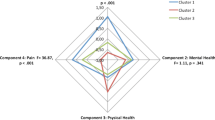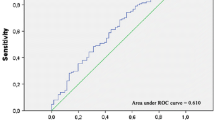Abstract
The most typical symptom of fibromyalgia (FM) is diffuse pain, and pain at specific points—tender points—is crucial for its diagnosis. By comparing healthy individuals and FM patients, this study was aimed at assessing pain and quality of life of Brazilian females with FM, while seeking for a correlation between pain threshold and quality of life. A total of 178 women were evaluated: 124 were FM patients and 54 were healthy women. Pain threshold at tender points was quantified by dolorimetry, and diffuse pain by means of the visual analogue scale (VAS); the Fibromyalgia Impact Questionnaire (FIQ) was used to evaluate quality of life. Statistical treatment of the data allowed for proposing two indexes: a pain threshold index (PT) and a quality of life one (QOL). PT is the lowest value among all pain thresholds measured at the 18 tender points; QOL is the mean of responses to the FIQ and VAS. Both indexes were tested and showed significant differences between the test and control groups. By pairing pain threshold values of each tender point in the test and control groups, it was found that the most sensitive points matched between the two groups, that is, the most sensitive anatomic spots in a healthy individual are also likely to be the most sensitive points in a person with FM. This suggests that a stimulus that provokes slight discomfort to a healthy person may produce more pain in FM patients—which may bear implications for FM clinical treatment. In this sample of Brazilian women, FM patients had both lower pain threshold and worse quality of life than healthy women.



Similar content being viewed by others
References
Wolfe F (1997) The relation between tender points and fibromyalgia symptom variables: evidence that fibromyalgia is not a discrete disorder in the clinic. Ann Rheum Dis 56:268–271
Croft P, Schollum J, Silman A (1994) Population study of tender point count and pain as evidence of fibromyalgia. BMJ 309:696–699
Caidahl K, Lurie M, Bake B, Johansson G, Wettweqvist H (1989) Dyspnea in chronic primary fibromyalgia. J Intern Med 226:265–270
Lurie M, Caidahl K, Johansson G, Bake B (1990) Respiratory function in chronic primary fibromyalgia. Scand J Med 22:151–155
Weiss DJ, Kreck T, Aalbert RK (1998) Dyspnea resulting from fibromyalgia. Chest 113:246–249
Wolfe F, Aarflot T, Bruusgaard D, Henriksson KG, Littlejohn G, Moldofsky H, Raspe H, Vaeroy H (1995) Fibromyalgia and disability. Scand J Rheumatol 24:112–118
Henriksson C, Burckhardt C (1996) Impact of fibromyalgia on everyday life: a study of women in the USA and Sweden. Disabil Rehabil 18:241–248
Wolfe F, Smythe HA, Yunus MB, Bennett RM, Bombardier C, Goldenberg DL, Tugwell P, Campbell SM, Abeles M, Clark P, Fam AG, Farber SJ, Fiechtner JJ, Franklin CM, Gatter RA, Hamaty D, Lessard J, Lichtbroun AS, Masi AT, McCain GA, Reynolds J, Romano TJ, Russel JI, Sheon RP (1990) The American College of Rheumatology 1990 criteria for the classification of fibromyalgia. Arthritis Rheum 33:160–172
Revill SI, Robinson JO, Rosen M, Hogg IJ (1976) The reliability of a linear analogue for evaluating pain. Anaesthesia 31:1191–1198
Huskisson EC (1974) Measurement of pain. Lancet 9:1127–1131
Rydén O, Lindal E, Udén A, Hansson SB (1985) Differentiation of back pain patients using a pain questionnaire. Scand J Rehab Med 17:155–161
Melzack R (1983) The McGill pain questionnaire. In: Melzack R (ed) Pain measurement and assessment. Raven Press, New York, pp 41–47
Russell IJ (1998) Advances in fibromyalgia: possible role for central neurochemicals. Am J Med Sci 315:377–384
Fischer AA (1987) Pressure algometry over normal muscle. Standard values, validity and reproducibility of pressure threshold. Pain 30:115–126
Tunks E, McCain GA, Hart LE, Teasell RW, Goldsmith CH, Rollman GB, McDermid AJ, DeShane PJ (1995) The reliability of examination for tenderness in patients with myofascial pain, chronic fibromyalgia and controls. J Rheumatol 22:944–952
Jacobs JWG, Geenen R, Van der Heide A, Rasker JJ, Bijlsma JWJ (1995) Are tender points assessed by manual palpation in fibromyalgia reliable? An investigation into the variance of tender point scores. Scand J Rheumatol 24:243–247
Bonica JJ (1990) History and pain concepts and therapies. In: Bonica JJ (ed) The management of pain. Lea & Febiger, Philadelphia, pp 2–17
Burckhardt CS, Clark SR, Bennett RM (1991) The fibromyalgia impact questionnaire: development and validation. J Rheumatol 18:728–733
Gottfried N (1991) Introduction to statistics: the nonparametric way. Springer, Berlin Heidelberg New York
Djikers M (1999) Measuring quality of life. Am J Phys Med Rehabil 78:286–300
American Physical Therapy Association (2001) Guide to physical therapist practice. Phys Ther 81:27–33
Wolfe F, Anderson J, Harkness D, Bennett RM, Caro XJ, Goldenberg DL, Russell IJ, Yunus MB (1997) A prospective, longitudinal, multicenter study of service utilization and costs in fibromyalgia. Arthritis Rheum 40:1560–1570
Skevington SM (1995) Psychology of pain. Wiley, Chichester
Clark WC, Clark SB (1980) Pain responses in Nepalese porters. Science 209:410–412
Haun MVA, Ferraz MB, Pollak DF (1999) Validação dos critérios do Colégio Americano de Reumatologia (1990) para classificação da fibromialgia, em uma população brasileira. Rev Bras Reumatol 39:221–230
Forseth KØ, Gran JT (1992) The prevalence of fibromyalgia among women aged 20–49 years in Arenal, Norway. Scand J Rheumatol 21:74–78
Nishikai M (1992) Fibromyalgia in Japanese. J Rheumatol 19:110–114
Prescott E, Kjøller M, Jacobsen PM, Danneskiold-Samsøe B, Kamper-Jørgensen F (1993) Fibromyalgia in the adult Danish population: I. A prevalence study. Scand J Rheumatol 22:233–235
Gracely RH, Petzke F, Wolf JM, Clauw DJ (2002) Functional magnetic resonance imaging evidence of augmented pain processing in fibromyalgia. Arthritis Rheum 46:1333–1343
Russel IJ (1998) Advances in fibromyalgia: possible role for central neurochemicals. Am J Med Sci 315:377–384
Mountz JM, Bradley LA, Alarcón GS (1998) Abnormal functional activity of the central nervous system in fibromyalgia syndrome. Am J Med Sci 315:385–396
Weigent DA, Bradley LA, Blalock E, Alarcón GS (1998) Current concepts in the pathophysiology of abnormal pain perception in fibromyalgia. Am J Med Sci 315:405–412
Crofford LJ (1998) Neuroendocrine abnormalities in fibromyalgia and related disorders. Am J Med Sci 315:359–366
Bonica JJ (1990) Definitions and taxonomy of pain. In: Bonica JJ (ed) The management of pain. Lea & Febiger, Philadelphia, pp 18–22
Clark SR, Jones KD, Burckhardt CS, Bennett R (2001) Exercise for patients with fibromyalgia: risks versus benefits. Curr Rheumatol 3:135–140
Jentoft ES, Kvalvik AG, Mengshoel AM (2001) Effects of pool-based and land-based aerobic exercise on women with fibromyalgia/chronic widespread muscle pain. Arthritis Care Res 45:42–47
Ramsay C, Moreland J, Ho M, Joyce S, Walker S, Pullar T (2000) An observer-blinded comparison of supervised and unsupervised aerobic exercise regimens in fibromyalgia. Rheumatology 39:501–505
Meiworm L, Jakob E, Walker UA, Peter HH, Keul J (2000) Patients with fibromyalgia benefit from aerobic endurance exercise. Clin Rheumatol 19:253–257
Offenbacher M, Stucki G (2000) Physical therapy in the treatment of fibromyalgia. Scand J Rheumatol 29:78–85
Nichols DS, Glenn TM (1994) Effects of aerobic exercise on pain perception, affect, and level of disability in individuals with fibromyalgia. Phys Ther 74:327–332
Mengshoel AM, Komnaes HB, Forre O (1992) The effects of 20 weeks of physical fitness training in female patients with fibromyalgia. Clin Exp Rheumatol 10:345–349
Mengshoel AM, Vollestad NK, Forre O (1995) Pain and fatigue induced by exercise in fibromyalgia patients and sedentary healthy subjects. Clin Exp Rheumatol 13:477–482
Author information
Authors and Affiliations
Corresponding author
Rights and permissions
About this article
Cite this article
Marques, A.P., Ferreira, E.A.G., Matsutani, L.A. et al. Quantifying pain threshold and quality of life of fibromyalgia patients. Clin Rheumatol 24, 266–271 (2005). https://doi.org/10.1007/s10067-004-1003-7
Received:
Accepted:
Published:
Issue Date:
DOI: https://doi.org/10.1007/s10067-004-1003-7




